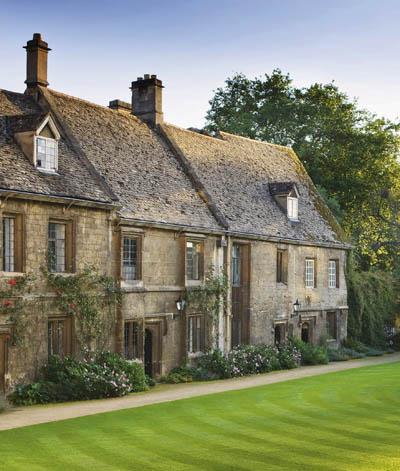Is this the oldest garden in England?
An Oxford college has a 730-year old garden – could this be England’s oldest, asks Mark Griffiths?


Alittle under three centuries ago, Oxford was endowed with a new college. In this university, ‘new' is rarely as novel as it sounds. Worcester College is the latest and most glorious incarnation of an academic phoenix that has roosted on the same palmy site since the Middle Ages.
In 1283, the Benedictine Abbey of St Peter at Gloucester established Gloucester College as its scholarly Oxford satellite. Before long, other abbeys were sending brethren to it to study. A flourishing intellectual community arose, only to perish come the Reformation. Restyled Gloucester Hall, in 1560, the buildings and land were acquired by the founder of St John's College, Oxford. Then, in 1714, a legacy from Sir Thomas Cookes led to this ancient institution's rebirth as a college in its own right. The only casualty was that word ‘Gloucester': Sir Thomas was a Worcestershire man.
Among the celebrations of the college's 300th anniversary, next February sees the publication of Worcester: Portrait of an Oxford College. The robes to rags to riches story makes a tale more colourful than most college chronicles. So does the extraordinary concentration of talents who have brought Worcester to its present glory. In terms of its buildings alone, they include Nicholas Hawksmoor, James Wyatt and William Burges, not to mention the gothically gifted Anon responsible for the Cottages, the wonderfully time-worn row that survives from medieval days.
A place and cast of such distinction demand special treatment. Worcester's Provost Prof Jonathan Bate has invited a range of authors to contribute on their specialist subjects and to go deep. As a result, fascinating discoveries have been made that will carry this book beyond college walls and old members' libraries.
Recently, Edward Wilson, Emeritus Fellow and former Garden Master of Worcester, gave me a preview of his chapter on the college's grounds. His excavations have produced something strangely rare in our gardening nation: a profile of a garden under continuous development since the reign of Edward I. It began with the Benedictines carving a cultivable plot from water meadows and willow beds. Here, they made a typical monastic hortus, a garden for medicinal herbs and vegetables.
In the 16th century, this expanded and evolved into the Provost's Garden, a walled paradise containing trees, elaborate beds, gravel walks and a rustic pavilion. Nearby, there stood an orchard which, likewise, may have been medieval in origin. By now, horticulture was also asserting itself elsewhere around the college as kitchen gardens and trees filled the buildings' interstices.
Then came Gloucester Hall's rebirth as Worcester College and an ambitious programme of construction and landscaping. The front quadrangle's hum-drum, path-crisscrossed lawn began its metamorphosis into one of Oxford's most brilliant coups de théâtre: a pristine sunken square bordered on two sides by slopes of equally flawless turf.
Exquisite houses, the beauty of Nature, and how to get the most from your life, straight to your inbox.
In the 18th century, the college began acquiring the parcels of land that now make up its 26 acres of grounds. Much tree-planting followed, with the account books for 1787 alone listing purchases of 15 species, among them no fewer than 17 Weymouth pines (Pinus strobus). In this period, two senior college members were notable plantsmen: William Sheffield, who was Provost from 1777 to 1795, and Stephen Long Jacob, a Fellow from 1788 to 1800. If it wasn't already an established tradition, these two introduced the horticultural connoisseurship that would become one of Worcester's most striking characteristics.
Early in the 19th century, it manifested itself in enthusiastic expenditure on maintenance and plants such as Aucuba japonica and Lonicera japonica, both bought in 1813, when they were still new and exciting exotics. These same Aucubas survive, and look remarkably verdant for 200 year olds. So does another purchase from 1813, the ‘Virginian Cedar' (Taxodium distichum Nutans) bought for two shillings on May 10. With its feet in a creek spanned by a bridge, this swamp cypress became, and remains, the embarkation point of one of Worcester's loveliest features, its lake, afloat now with waterlilies and fringed with groves that would have left nothing even to Claude's idealising imagination.
Mr Wilson has found that the lake was created at least as early as 1817 and was probably influenced by the great exponent of the Picturesque Richard Payne Knight, with whom Worcester had business dealings in 1799. Here, it would seem, is the reason for the college's acquiring Knight's major works on landscape and taste so soon after their publication. He was hardly standard Oxford library fare.

A century later, Worcester embraced a very different aesthetic. In 1903, Alfred Parsons, painter and pioneer of the Arts-and-Crafts garden, was employed to remodel the Provost's Garden. An exquisite rose parterre, the result was the most painterly of all his designs, but not so very far in conception from the Renaissance knots that once filled the same site.
Parsons brought much else to the college-not least, Rapunzel-racemed Wisteria of the kind he had witnessed in Japan and an introduction to Ellen Willmott, epic gardener and patron of Britain's premier plant-explorers. As their discoveries arrived from far-flung parts, she shared them with Worcester. Several of these treasures survive; indeed, some have only recently come to light, notably a magnificent and previously undescribed form of Rosa filipes, now named Wilson's Worcester in dual tribute to Ernest Henry Wilson (its collector in China) and Edward Wilson (its rediscoverer at Worcester).
Another of her lasting gifts was the fabulous lilac Syringa Miss Ellen Willmott. Each time I encounter its perfumed white cloud hovering in the college's venerable orchard, I think: ‘That's the real Miss Willmott's ghost, not spiky old Eryngium giganteum.' Here, then, are hundreds of years of hard horticultural acts to follow. Early in the present century, Worcester succeeded in outstripping them all with the appointment of Simon Bagnall as Head of Gardens and of Edward Wilson as Garden Master. Within five years, they had given the college the most important and exciting gardens in Oxford. Country Life reported their triumphant restoration of the Provost's Garden in 2007.
But what most visitors see is the profuse planting around the public buildings, and what they remember is its extraordinary marriage of hardy and tender, English and exotic, novel and classic. In late summer, this is nowhere more obvious than in the long mixed border that flashes brilliant behind the sunny Cottages, leaps a tunnel-like archway curtained with Wisteria and Campsis, and continues along a high wall (a battlement that supports its own secret garden), growing ever more shadowy and luxuriant before ending in the cool of the lake.
Mr Bagnall had Gertrude Jekyll in mind in 2005, when he began this tour de force. Her influence is still evident in the border's tonal transitions, in the way it passes from sun to shade, shifting from silvers, blues, pinks and mauves through yellow, scarlet and orange, before settling into sombre greens and bronzes with will-o'-the-wisps of colour. But borders are always works in progress, and Worcester's soon progressed beyond anything Miss Jekyll would have recognised.
Its creation coincided with a revival of interest in hardy herbaceous perennials, and with a welter of new introductions. As a result, familiar stalwarts such as Nepeta, Echinops ritro, Eupatorium maculatum and Calamagrostis Karl Foerster are joined at the border's sunny centre by newcomers such as Veronicastrum Fascination (airy lilac-pink spires) and by long-overdue comebacks such as Galega His Majesty (coconut-scented pea flowers in lavender and white).
Similarly, at its sylvan bourn, the silver brocade blades of Phalaris arundinacea Picta, an ornamental grass grown in English gardens since the 16th century, consort with the amethyst blooms of recently arrived Tricyrtis cultivars. These two arise from pillows of Persicaria virginiana Lance Corporal, a superb knee-high groundcover for shade with mint-green oval leaves, each marked with a chocolate chevron and, in early autumn, wands of dark coral flowers.
Mr Bagnall is a master at building borders with harmonious trios such as these. They form the permanent fabric of his compositions. But he also makes room for temporary residents. Some are annuals, ranging from hot-tempered Rudbeckia to serene Nicotiana and candy Cleome and Cosmos, and including surprises such as edible chard and beet with leaves as gaudy as wine gums.
Others are tender perennials, overwintered in the college's glasshouses and planted out in early summer. These include miniature papyrus (Cyperus alternifolius), Dahlia David Howard, with bronze leaves and flowers the colour of the perfect apricot flan, and various bananas (Musa and Ensete), which loom at the back of the border, fanning their more demure companions with emerald and ruby paddles.
The Worcester way, however, is innovation through exploration. Those Georgian Fellows weren't really sure that their Asian prizes were hardy when they planted them, let alone that they'd still be with us 200 years later. Messrs Wilson and Bagnall have pursued a similarly adventurous policy. As a result, the college's new border became a test bed for novelties and rarities whose requirements were uncertain and which were still widely thought to be tender. At Worcester, they've proved to be nothing of the kind.
Year after year, the Sierra Madre cardinal flower (Lobelia laxiflora subsp angustifolia) produces flocks of flowers, tubular and fiery scarlet with tawny yellow lips-a bushy semi-herbaceous perennial that needs no more fuss than a winter mulch. The same is true of the Bomarea species among the bananas at the back of the border. In late spring, their twining stems emerge from well-mulched fleshy rootstocks to drape hazel-rod wigwams with umbels of bell-shaped blooms in flame, tangerine, magenta and cassis-speckled lime.
It was in this border that I first saw the gargantuan Tetrapanax Rex treated with anything other than trepidation (and repaying the lack of mollycoddling with bigger leaves and more generous offshoots than ever). Nearby grows x Chitalpa tash-kentensis. A hybrid between the desert willow Chilopsis linearis and Catalpa speciosa and/or C. ovata, this is a fast-maturing deciduous tree to about 20ft tall (but tolerant of pruning in spring). From midsummer to autumn, its canopy of slender leaves is decked with foxglove-like flowers, each about 2in across, with frilly rose-quartz lobes and a maroon-veined golden throat. These are borne low enough to form a climax to the surrounding perennials, and to be inspected close-up by the many visitors they captivate.
Having withstood recent winters, x Chitalpa has a future as a good droughtproof doer for sun-baked public spaces. It's at Worcester, however, that this newcomer has really found its place in the garden as that rare thing, a tree that's sufficiently decorous and decorative to stand in a border in harmony with its neighbours and without overshadowing them. As the college approaches its 300th (or 731st) birthday, it has much to be proud of-not least having nurtured one of the nation's longest-surviving and most dynamic gardens.
Worcester College, Oxford, Oxfordshire (www.worc.ox.ac.uk; 01865 278300), is at the junction of Beaumont Street and Walton Street. The college is open daily to visitors from 2pm to 5pm. ‘Worcester: Portrait of an Oxford College' will be published next February by Third Millennium (to order, visit www.tmiltd.com)
* Follow Country Life magazine on Twitter
* Subscribe to Country Life; Country Life Digital Edition
Country Life is unlike any other magazine: the only glossy weekly on the newsstand and the only magazine that has been guest-edited by His Majesty The King not once, but twice. It is a celebration of modern rural life and all its diverse joys and pleasures — that was first published in Queen Victoria's Diamond Jubilee year. Our eclectic mixture of witty and informative content — from the most up-to-date property news and commentary and a coveted glimpse inside some of the UK's best houses and gardens, to gardening, the arts and interior design, written by experts in their field — still cannot be found in print or online, anywhere else.
